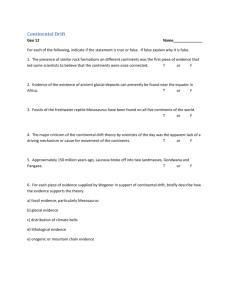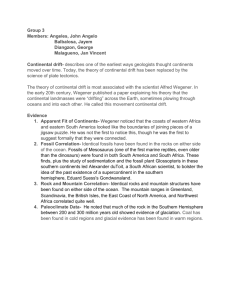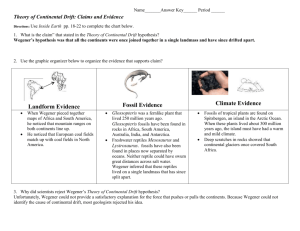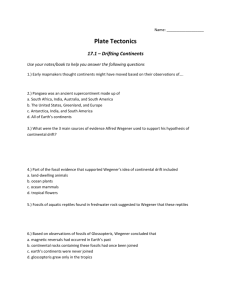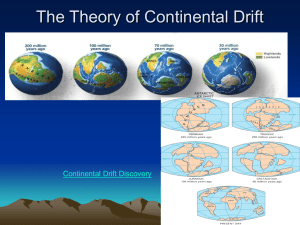Pangaea Activity - Dillon Environmental Science
advertisement
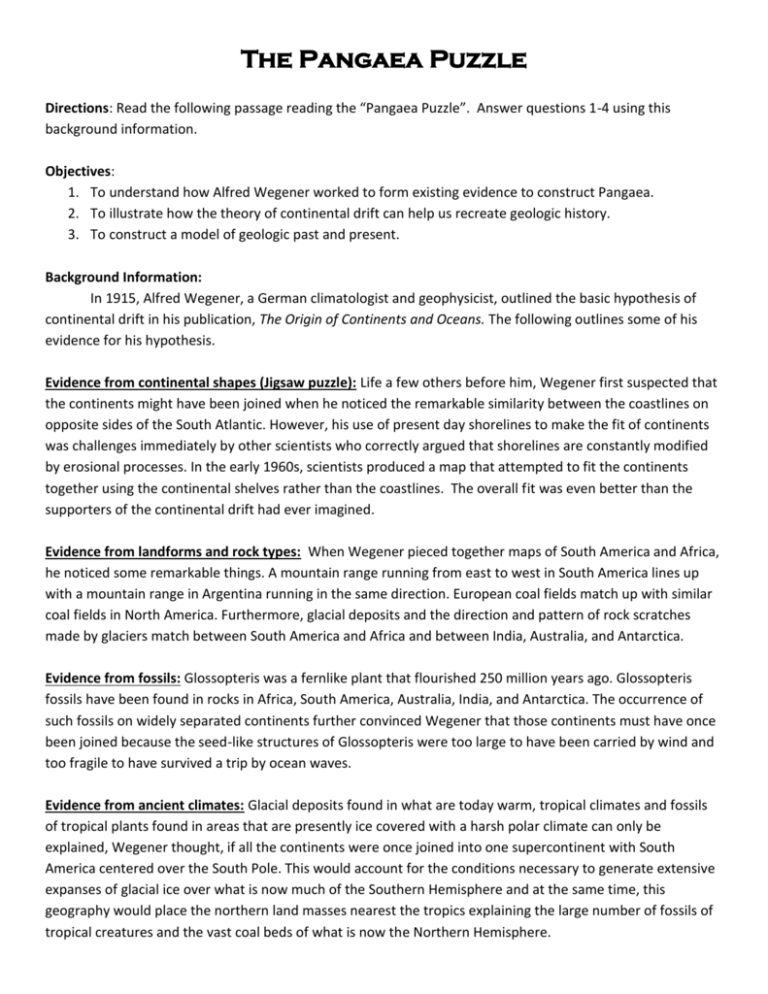
The Pangaea Puzzle Directions: Read the following passage reading the “Pangaea Puzzle”. Answer questions 1-4 using this background information. Objectives: 1. To understand how Alfred Wegener worked to form existing evidence to construct Pangaea. 2. To illustrate how the theory of continental drift can help us recreate geologic history. 3. To construct a model of geologic past and present. Background Information: In 1915, Alfred Wegener, a German climatologist and geophysicist, outlined the basic hypothesis of continental drift in his publication, The Origin of Continents and Oceans. The following outlines some of his evidence for his hypothesis. Evidence from continental shapes (Jigsaw puzzle): Life a few others before him, Wegener first suspected that the continents might have been joined when he noticed the remarkable similarity between the coastlines on opposite sides of the South Atlantic. However, his use of present day shorelines to make the fit of continents was challenges immediately by other scientists who correctly argued that shorelines are constantly modified by erosional processes. In the early 1960s, scientists produced a map that attempted to fit the continents together using the continental shelves rather than the coastlines. The overall fit was even better than the supporters of the continental drift had ever imagined. Evidence from landforms and rock types: When Wegener pieced together maps of South America and Africa, he noticed some remarkable things. A mountain range running from east to west in South America lines up with a mountain range in Argentina running in the same direction. European coal fields match up with similar coal fields in North America. Furthermore, glacial deposits and the direction and pattern of rock scratches made by glaciers match between South America and Africa and between India, Australia, and Antarctica. Evidence from fossils: Glossopteris was a fernlike plant that flourished 250 million years ago. Glossopteris fossils have been found in rocks in Africa, South America, Australia, India, and Antarctica. The occurrence of such fossils on widely separated continents further convinced Wegener that those continents must have once been joined because the seed-like structures of Glossopteris were too large to have been carried by wind and too fragile to have survived a trip by ocean waves. Evidence from ancient climates: Glacial deposits found in what are today warm, tropical climates and fossils of tropical plants found in areas that are presently ice covered with a harsh polar climate can only be explained, Wegener thought, if all the continents were once joined into one supercontinent with South America centered over the South Pole. This would account for the conditions necessary to generate extensive expanses of glacial ice over what is now much of the Southern Hemisphere and at the same time, this geography would place the northern land masses nearest the tropics explaining the large number of fossils of tropical creatures and the vast coal beds of what is now the Northern Hemisphere. Name: _______________________________________ The Pangaea Puzzle Directions: Answer the following questions using the “Pangaea Puzzle” background information or using your “best-fit” configuration of the continents. Background Information Questions: 1. Why is the fact that continents fit together like pieces of a jigsaw puzzle considered evidence for continental drift? 2. How do fossils fit as evidence for continental drift? 3. How are the coal fields in North America and European countries regarded as evidence for continental drift? 4. How can we explain the remains of fossilized tropical plants and animals found beneath the ice of Antarctica? AFTER Pangaea Reconstruction Questions: 5. From your reconstruction of the continents, where did the continents fit together well? 6. Where did problems occur during your reconstruction? 7. What could you change to the continents to make them fit together better? 8. How could the overlaps and large gaps be explained in your model? (Hint: What is the outline of the coasts was not the same as the boundaries of the continents themselves?) 9. According to your model of the continents, what similarities would joining continents have? (Hint: Look in your notes under “Evidence”) 10. Compare your large landmass with that of the student beside you. Did he/she come up with a landmass that was different from yours? Explain how it was different or similar.

